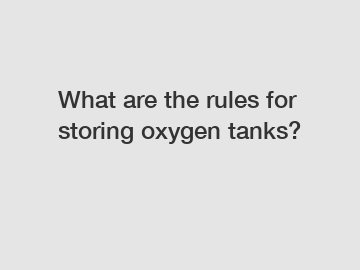What are the rules for storing oxygen tanks?
What are the rules for storing oxygen tanks?
Oxygen tanks are crucial for individuals who require supplemental oxygen due to various health conditions. Whether you are a healthcare professional or an individual using oxygen therapy at home, it is essential to understand the rules for storing oxygen tanks safely. In this article, we will explore everything you need to know about storing oxygen tanks, ensuring both your safety and the integrity of the tanks themselves.
1. Proper ventilation:

One of the crucial rules for storing oxygen tanks is to ensure proper ventilation in the designated storage area. Oxygen supports combustion, making it highly flammable. Therefore, it is vital to store oxygen tanks in a well-ventilated space to prevent the accumulation of oxygen-rich air, reducing the risk of fire.
2. Distance from flammable substances:
Oxygen tanks should be stored a safe distance away from flammable substances such as oil, grease, paper, and other flammable liquids. Even a small spark could ignite these substances in the presence of oxygen, resulting in a potentially dangerous situation. Keep the storage area clean, free from clutter, and avoid storing any other flammable materials nearby.
3. Secure storage:
To prevent accidents or damage, ensure that oxygen tanks are stored securely, preventing them from falling or being knocked over. Use storage racks or stands specifically designed for oxygen tanks to avoid any potential hazards. Additionally, the storage area should be adequately labeled, indicating the presence of oxygen and the need for caution.
4. Temperature and humidity considerations:
It is important to store oxygen tanks in a location that maintains a stable temperature and humidity level. Extreme temperatures and high humidity can negatively affect the integrity and performance of the tanks, potentially leading to leaks or other hazards. Ensure that the storage area is within the recommended temperature range and humidity levels specified by the tank manufacturer.
5. No smoking policy:
Smoking near oxygen tanks is extremely dangerous and should be strictly prohibited. Oxygen-enriched air can cause even a small spark to turn into a major fire. Clearly communicate and enforce a strict no smoking policy in the vicinity of the storage area to minimize the risk of fire incidents.
6. Regular maintenance and inspection:
To ensure the safety and functionality of oxygen tanks, regular maintenance and inspection are essential. Regularly check for any signs of damage, leaks, or other issues that may compromise the integrity of the tanks. If any problems are detected, promptly address them or seek the assistance of a professional to avoid potential hazards.
7. Training and education:
Whether you are a healthcare professional or an individual using oxygen therapy at home, it is crucial to receive proper training and education on the safe handling and storage of oxygen tanks. Understanding the correct procedures and rules for storage will help prevent accidents and maintain a safe environment for everyone involved.
In conclusion, storing oxygen tanks safely is of utmost importance to ensure your well-being and the safety of those around you. By following the rules and guidelines mentioned above, you can minimize the risk of fire hazards and accidents associated with oxygen storage. Remember to maintain proper ventilation, store tanks away from flammable substances, secure the storage area, control temperature and humidity, enforce a strict no smoking policy, conduct regular maintenance and inspections, and seek proper training and education. By adhering to these guidelines, you can have peace of mind knowing that you are storing oxygen tanks in the safest and most responsible manner.
Contact us to discuss your requirements of Microbulk Tank, Bulk Cryogenic Storage Tank, Ln2 Micro Bulk Tank. Our experienced sales team can help you identify the options that best suit your needs.

Comments
0